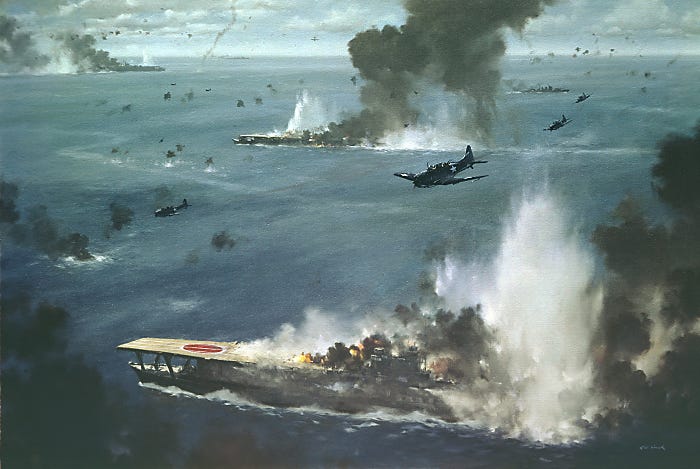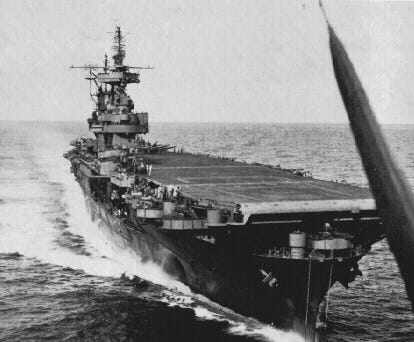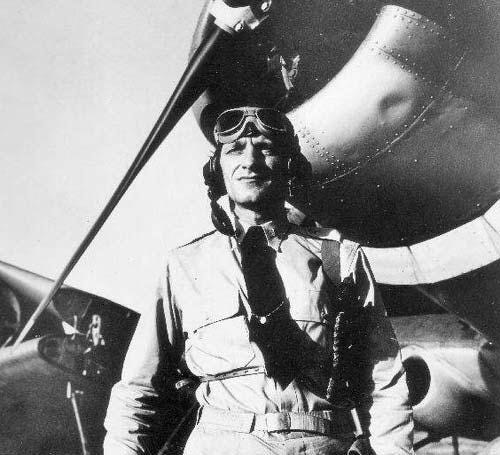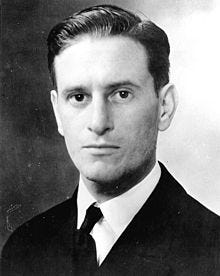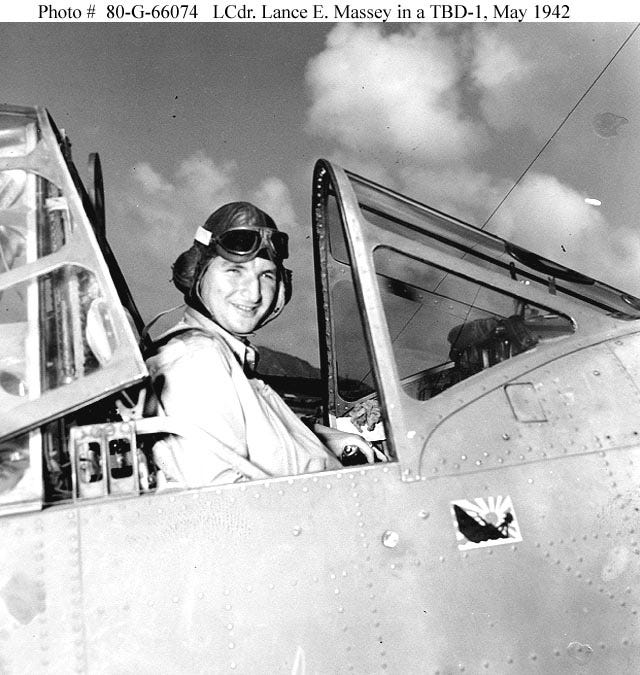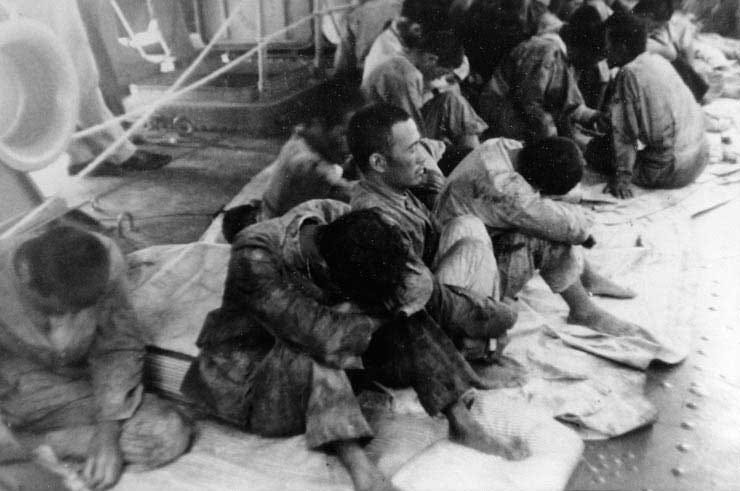Five Minutes that Changed History. The Battle of Midway at 81 Years
Walter Lord, whose history of the Battle of Midway is still considered the classic presentation of the battle, wrote:
“Even against the greatest of odds, there is something in the human spirit – a magic blend of skill, faith, and valor – that can lift men from certain defeat to incredible victory.”
This is an article that I planned to write over the weekend but had to finish writing my last final exam of the year. Since my quizzes, tests, and exams are written not only challenge my students but give them a study guide for when they take college-level history and literature classes, writing them takes a lot of time, and then. I started yesterday but wasn’t happy with the first product. But I digress.
I always tell my students that history is more than lists of dates and events, but that many of those events have meaning, not just in the past but in the present; thus, when those dates come around, it is worth our time to reflect upon them. Likewise, there are certain dates, or clusters of dates that regularly feature in history in one country as important; for example the 9th of November in Germany is known as “Schicksaltag” or the date of fate. In 1918, Kaiser Wilhelm II abdicated, bringing about the spontaneous creation of the Weimar Republic. In 1923 Hitler launched his abortive Bier Hall Putsch in Munich. In 1938 Josef Goebbels ordered the attack on Jewish houses of worship, community centers, and businesses known as Reichskristallnacht, or the Night of Broken Glass, and in 1989 the Berlin Wall fell.
Though the United States has been around a relatively short time as far as history goes, we have a number of dates that show up repeatedly, two of them are June 4th and June 6th. Now, most Americans at least have a vague idea about D-Day, which occurred on June 6th 1944, most are ignorant of other events that occurred on June 6th, as well as June 4th that are just about as significant to us as a nation and the world. I will deal with D-Day tomorrow, but a few notable events, let’s call them, appetizers from June 4th before I move on to our main course, the Battle of Midway.
On June 4th, 1919 the Nineteenth Amendment to the U.S. Constitution was passed by the Congress and sent to the states for ratification. This paved the way for Women’s Suffrage including to right to vote and hold elected office. Sadly, there is a whole subculture of American Fundamentalist Christians who believe that a woman’s place is in the home, unconditionally serving their husband every command, submitting to every demand, and being perpetually pregnant so they can produce “quiver fulls” old children who can be homeschooled to eventually take control of the country. See the Happy Shinny People documentary about the Duggar Family and Bill Gothard’s organization and seminars.
In 1939 U.S. Border and Customs officials, under the orders of the State Department, refused to allow the S.S. St. Louis, a passenger ship with, 963 Jewish refugees from Hitler’s Germany to dock. The ship returned to Germany, where 200 passengers died in the Holocaust, casualties of American emigration policies, antisemitism, the isolationist views of many Americans, and the pro-Nazi America First movement.
Though not directly connected to the U.S. History, the British completed the Miracle of Dunkirk, on June 4th 1940. The Royal Navy aided by hundreds of civilian manned craft evacuated 338,000 British and French troops from France. Most of the ships and boats involved being privately owned by volunteers who responded to the emergency. Dunkirk kept Britain in the war and as the Nazi threat grew, the United States responded by passing the Lend Lease Act, in March 1941. Lend Lease became one of the defining moments that helped win the war, as any nation fighting the Nazis was fighting in our interest and could get American weapons and war supplies.
But today, I focus on just one event, the Battle of Midway, a subject that has captivated my attention since 1972 when as a 7th grader at Stockton Junior High School, I read Walter Lord’s classic account of the battle, Incredible Victory. Since then I have never let it go, and so much was because of the way Lord made the men who fought come alive on those pages. I have numerous books about Midway on the shelves of my personal library, some of which have more details that were not available when Lord wrote, but Lord spent large amounts of time with the Americans and Japanese participants, as he did with the participants of so many of the books that he wrote. Lord’s writing style influences mine, especially in my first book Mine Eyes Have Seen the Glory: Religion and the Politics of Race in the Civil War Era and Beyond, in which I try to tell the story using the words of those present.
Until June 1942, the war in the Pacific was going the way of the Japanese. After Pearl HarborU.S. Navy. The Battle was a tactical draw, but the Japanese lost two carriers they planned on using against Midway, one due to heavy battle damage and the other due to the heavy losses sustained by its air group. Likewise, they over estimated the damage they caused, assuming that they had sunk the USS Yorktown in addition to the USS Lexington, thus reducing the number of American carriers available to oppose them.
The Japanese did not know that the US Navy had broken the Japanese Naval Code. Nor did they know that US Navy Pacific Fleet codebreakers discovered that the Japanese were going to attack Midway Island, northwest of Pearl Harbor with the goal of defeating the remaining aircraft carriers of the U.S. Pacific Fleet. The Japanese assumed that the Americans would not know of their plans until they attacked Midway, at which time the they would defeat the American carriers sent to defend Midway. They outnumbered the Americans in every category. Admiral Isoruku Yamamoto developed an overly complex plan and split his fleet so that the various elements could not support each other if attacked.
U.S.S. Enterprise
Since the Americans knew the Japanese plan they positioned TF-16 with the USS Enterprise and USS Hornet, under the command of Rear Admiral Raymond Spruance, not long returned from the Doolittle Raid northeast of Midway. They were followed by TF-17 under Rear Admiral Frank “Jack” Fletcher, with Yorktown, hastily repaired but fully operational and embarking Carrier Air Group Three from the USS Saratoga, which was undergoing repairs from a torpedo hit from a Japanese submarine. The Japanese scouting line of submarines deployed between Midway and Pearl Harbor to report their presence, arrived days after the American task forces passed.
The battle began early on the morning of June 4th, 1942, and included many acts of heroism and sacrifice when the first Japanese attack group launched a massive attack on Midway. Despite the damage done, the mission leader recommended a follow-up strike. Admiral Chuichi Nagumo and Chief of Staff Ryunosuke Kusaka debated their next move.
The aircraft of the first wave was expected to return at about 0800 and as of yet, none of his scout aircraft had reported any American ships, and even the scout plane from the heavy cruiser Tone, which due to a catapult problem was delayed in carrying out its sector of the hunt for the American carriers should be returning from its search. Likewise, over the past half hour the Japanese combat air patrol of Mitsubishi AM6-2 Zeros fought off determined attacks by 4 U.S. Army Air Corps B-26 Marauders and 6 Navy TBF Torpedo Bombers from Midway, all equipped with torpedoes. So at 0715, with no reports of US Navy ships, and the recommendation for the follow-up attack, the Japanese commander, Admiral Chuichi Nagumo, decided to have his second attack wave rearm to attack Midway.
The decision required Nagumo’s crews to change the payloads of his attack aircraft, the Aichi-99 Val Dive Bombers and Nakajima B5N “Kate” Torpedo Bombers, which were armed with torpedoes and armor-piercing bombs needed to sink ships. Such ordnance was of little use against land targets and the aircraft needed to be rearmed with high explosive bombs. This was difficult as the Kates had to be taken back to the hanger decks of Nagumo’s flagship Akagi and the Kaga. There the Aviation ordnance men had to lower the nearly one-ton, 17-foot-long Type-91 aerial torpedoes from the planes and replace them with two 250 KG land attack bombs, which also required that the torpedo rack be replaced with bomb ranks. Replacing the racks and exchanging between the torpedo and bombs was not a trivial process and could take more than two hours to complete.
At 0728 Nagumo and Kusaka were stunned to receive a message from Tone’s scout plane that it had discovered 10 surface ships, but offered no details. Normally, the decision would be easy, he would immediately attack the ships, however, over half of the Kates were below with their torpedoes unloaded. At 0745 he ordered that the second strike on Midway be postponed, and the aircraft prepared to attack surface ships. To ascertain the types of ships he sent a terse message to the pilot of the aircraft to ascertain the ship types and maintain contact. But at 0750, as he waited for a response, more aircraft from Midway, this time 16 Marine Corps SBD Dive Bombers of VMSB-241 commanded by Major Lofton Henderson were preparing to attack. Henderson’s pilots were inexperienced, none had seen combat, and none had flown an SBD until a few days before, as such they were not able to conduct the dive bombing attacks which were the strength of the aircraft. As a result, the aircraft made glide bombing attacks which were low-angle attacks that exposed an aircraft to enemy fighters and anti-aircraft fire much longer. But they were brave, they scored no hits, Major Henderson was shot down and killed, and seven other aircraft were lost.
The Japanese had smashed another attack. It was 0812. During the attack Nagumo demanded to know the type of ships, and at 0809 the scout plane reported that it consisted of 5 cruisers, and no carriers. Kusaka wanted the Midway attack carried out, but the evasive maneuvers required to dodge bombs and torpedoes disrupted the fleet’s formation and required the combat air patrol leader to replace his aircraft with Zeros from the second wave, leaving any attack without fighter escort. Then at 0814 lookouts spotted 15 Army Air Force B-17 Bombers that attacked from 20,000 feet. They scored no hits and lost no aircraft, but when the attack ended at 0820, the Japanese fleet was further disrupted even as the carriers attempted to recover the aircraft from the first attack on Midway. But, the surprises kept coming.
At 0820 Nagumo was stunned by a message from Tone’s scout plane reported a carrier. Nagumo and Kusaka could not believe that the scout plane which had first reported the contact 52 minutes earlier had not seen such a big ship. Once again plans were changed, the second strike on Midway was cancelled as they realized that they had to attack the carrier, but how to do it was the issue. Did they continue to rearm the second wave aircraft with torpedoes and armor piercing bombs and send it? Did they wait to recover and rearm the first wave? Did they wait until the combat air patrol was replenished and enough fighters were available to escort the strike force? Or some combination of the above.
VSMB-241 Pilots at Midway, May 1942
But even that was disrupted when 11 obsolete Vought SB2U-3 Vindicator Dive Bombers of VMSB-241 under Major Benjamin Norris began their attack at 0820, too scored no hits and 4 aircraft were shot down. At 0830 Rear Admiral Tamon Yamaguchi commanding Carrier Group Two, recommended an immediate attack by bombers alone, which was rejected by Nagumo and Kusaka who had decided to recover the aircraft of the first wave which were running out of fuel. If they waited and the aircraft had to “splash” many irreplaceable pilots, bombardiers, and aircrew could be lost. The decision was made. Land the and refuel and rearm the first wave, finish rearming the second while readying the fighters. While that would take time, the attack would not go off half-cocked, inviting massive losses of aircraft, as they had seen happen to the Americans this morning.
The flight deck personnel aboard the Japanese carriers hurriedly cleared the flight decks of the aircraft of the second wave in order to recover the first wave. On the hangar decks the aircrews again began the task of removing high explosive bombs from the attack aircraft, replacing those of the Val Dive Bombers with 250 KG (550 LB) armor piercing bombs. The Kates now had to have their bombs and bomb racks removed, and the sweating sailors moved the massive torpedoes to the aircraft. Feeling the pressure to rearm the aircraft as fast as possible, normal safety procedures were ignored. The land attack bombs were simply rolled to the sides of the hangar deck instead of being returned to the ammunition magazines below deck in order to meet Nagumo’s deadline of 1100 to launch the strike against the American carrier.
As aircraft were recovered and the fleet attempted to regain its tight box formation, another report was received from Tone’s scout plane at 0855. This time it was a report of 10 torpedo planes flying toward the task force, but with the intense focus on preparing the attack, this report was paid little attention. By 0900 all the aircraft were recovered, while some needed repairs and a number of wounded pilots and aircrew members were taken to sick bays, the preparations for the coming strike were finalized. The attack would be made by 35 Kate torpedo bombers and 36 Val dive bombers escorted by 12 Zeros, though Nagumo would have preferred more of the fighters, and if all went according to plan, they would take off at 1030.
But at 0918 lookouts aboard the heavy cruiser Chikuma reported 16 torpedo planes on the horizon at a distance of 20 miles, coming straight for the task force as Tone and several destroyers began laying a smoke screen. The aircraft were the 15 TBD Devastators of LCDR John Waldron’s Torpedo 8 from the Hornet. The TBDs obsolete. When introduced in 1937, it was the most advanced torpedo bomber in the world, but by 1942 it was hopelessly outclassed, slow, and underpowered to begin with; they could not launch their torpedoes above 115 miles an hour as they maintained a straight course to their targets.
LCDR John Waldron
The Pilots of Torpedo 8, the only survivor, Ensign George Gay, front center
Waldron, a Sioux Indian graduate of the Naval Academy stood determined to press the attack and almost immediately the Japanese ships began taking evasive action. Then without warning Torpedo 8 was attacked by a swarm of Zeros. Soon all but three were shot down, including Waldron. The remaining TBDs pressed the attack and all were shot down. Only Ensign George Gay survived, hiding under a life vest in order to avoid being picked up by the Japanese. The other 14 pilots and 15 tail gunners were killed, and at 0936, the Japanese reported the end of the attack. Still, numerous Japanese officers noted the near Samura-like courage of the Americans.
LCDR Eugene Lindsey
The Pilots of Torpedo 6
At 0940 LCDR Gene Lindsey, the commander of Enterprise’s Torpedo 6 sighted the Japanese at a range of 20 miles. However, the Japanese were steaming away from him at high speed and the approach to the target would take 20 minutes. When they were 15 miles out close to 25 Zeros began attacking them, and by 0948 only 4 remained. They pressed their attack but scored no hits, and made their escape. Gene Lindsey was among those killed, and by 1000 their attack was finished.
LCDR Lem Massey’s Torpedo 3 from Yorktown sighted the enemy and made their approach and immediately the Zeros swarmed them. Of Massey’s squadron of twelve TBDs, only four, maybe five aircraft launched their torpedoes scoring no hits. 10 of the 12 aircraft were shot down, and Massey too, died in the attack. In all 35 of the 41 TBDs were shot down. Of the pilots and gunners in the downed aircraft, only George Gay survived. The sacrifice of the Torpedo squadrons would not be in vain, but the words of Tennyson:
Cannon to right of them, Cannon to left of them, Cannon in front of them Volleyed and thundered; Stormed at with shot and shell, Boldly they rode and well, Into the jaws of Death, Into the mouth of hell Rode the six hundred.
The torpedo planes were victims of a poorly coordinated attack. The fighter squadrons lost contact with them, communication between them was lost, and with the exception of Torpedo 8 the rest of Hornet’s air group did not locate the Japanese. While returning to the ship numerous aircraft ran out of fuel and needed to ditch into the waters of the Pacific, with loss of life.
The Japanese appeared to be on the verge of yet another victory. Right enemy attacks had been defeated with no damage to the strike force. Nagumo’s carriers turned into the wind as the fully armed and field aircraft of the attack group sat on the flight decks of his four carriers, propellers spinning awaiting permission to take off. At 1020 Nagumo ordered the launch and flight deck officers began to signal for the aircraft to take off as flight deck crews removed the chock blocks from the wheels of the aircraft.
However, the First Carrier Strike Group, could not have been more vulnerable. The fully fueled and armed aircraft on the flight decks, those being fueled and armed on the hanger decks which were still full of unstowed bombs, and portable fuel carts were volcanoes ready to explode. Likewise, the entire Japanese combat air patrol was at sea level as they finished off the last hapless TBDs. None were in a position to protect against bomber attacks of any kind even as the first aircraft began roaring down the flight decks. Then, at 1022 lookouts around the fleet screamed out the warning, “Enemy Dive Bombers!”
Overhead the Dauntless’s of three squadrons, Enterprise’s air group under command of CDR Wade McClusky, with Bombing 6 led by LT Dick Best and Scouting 6 under LT Earl Gallagher, along with CDR Max Leslie’s Bombing 3 from Yorktown began their dives at the Japanese carriers.
Kaga was hit by an avalanche of bombs from Bombing and Scouting 6 who followed McClusky as he dove into the attack. Kaga was hit by at least four 1000 LB bombs, and suffered from at least five near misses, in the chaos of exploding planes and ammunition nobody could really make a careful count. Captain Jisaku Okada Was one of the first casualties when a bomb hit a portable fuel pump directly in front of the bridge, killing him and most of the bridge crew. Within minutes the ship was aflame from stem to stern, an inferno so hot that paint on the sides of the ship burned. Commander Takisha Amagai, the Air Officer attempted to organize firefighting parties but there was no water pressure, and realizing the hopelessness of the situation he ordered the remaining pilots and aircrew to abandon the ship since he heard no orders. The mighty and beloved ship burned throughout the day, continuously wracked by explosions. A small group of sailors remained aboard as a bucket brigade to fight fires, eventually they obeyed orders to abandon ship and Kaga sank following two massive explosions at 1925.
Dick Best of Bombing Six was surprised when Wade McClosky dove on Kaga as normally the lead sections would attack the next ship in line. So Best, now leading the three aircraft of Bombing 6’s First Section flew on to the next target, Nagumo’s flagship, Akagi.
Aboard the flagship, everyone was taken by surprise when a lookout screamed “dive bombers!” Admiral Kusaka was watching the first aircraft begin its takeoff. Captain Aoki, her skipper was watching the Zeros chase the last of the Torpedo Bombers, while others were transfixed by Kaga’s transition from an invincible warship to a floating inferno. Best’s three aircraft had a clear shot at the flagship, the first bomb landed just five yards away from the ship, tearing through a radio aerial on the way, sending a shudder through the ship. The second hit almost simultaneously next to the bridge near the elevator and exploded among the armed aircraft aircraft, fuel carts and bombs that crowded the hangar deck, turning it into a hellscape. The flames spread up to the flight deck, igniting everything on it. The final bomb landed amid the aircraft parked near the stern on the flight deck setting them afire and jamming the ship’s rudder. As he looked down from the bridge, the carrier’s air group leader, Commander Mitsuo Fuchida who led the attack on Pearl Harbor but recovering from Appendicitis, began to cry.
Akagi’s crew fought the flames but suffered from their intensity, and the continued explosions. The power was out, and the pump’s didn’t work, which meant there was no pressure in the fire fighting hoses, while damaged valves prevented the flooding of the magazines. In frustration and rage, the damage control officer, Commander Dobashi buckled on his Samurai sword, determined to at least die as a warrior. Additionally, the ship could not be steered and was steaming in circles, while orders to the engine rooms went unanswered. A messenger went to check and found that the machinery was undamaged but the entire crew of the starboard engine room had been suffocated by flames which were sucked down the ventilation system. The ship’s Navigator, Commander Miura, had no choice, with the ship out of control and half the engineers dead, he cut power to the boilers and brought the ship to a halt at 1042.
Admiral Nagumo no longer had a functional flagship, and he was convinced by Kusaka to transfer his flag to the Light Cruiser Nagara, while Captain Aoki and the surviving crew attempted to save the ship. The only escape was from a bridge window, and at 1043 they climbed a rope to the flight deck, Nagumo landed lightly, but Kusaka, a bit on the heavy side sprained both ankles. They made their way through the burning aircraft and wreckage to a launch from a destroyer which took them to Nagara. Despite their best efforts the fires could not be controlled and with no hope of saving the ship, Captain Aoki ordered the survivors to gather on the anchor deck in the less damaged bow of the ship to order that they abandon ship and transfer the Emperor’s portrait as Kaga sank. At 2000 small boats began evacuating the ship, and as Captain Aoki was refusing to leave, Commander Miura returned to the ship from the destroyer from which he was coordinating the evacuation, and instead of pleading with his commanding officer he scolded him, finally convincing him to abandon ship. They sought permission to scuttle Akagi but Admiral Yamamoto who once commanded her refused until 0450 when he gave the order to sink his beloved former command.
As the bombers from Enterprise laid waste to Akagi and Kaga, Max Leslie and Bombing 3 flew in from the opposite direction and took Soryu by surprise, once again a lookout shouted “Dive bombers!” Max Leslie pushed his stick forward at 1025 followed by his squadron. Leslie had no bomb to drop because his electronic bomb arming circuit malfunctioned, and his bomb dropped not long after taking off. Nonetheless, he led his aircraft in the face of stiff anti-aircraft fire, pulling up as the aircraft behind him started dropping their bombs. At least three bombs hit, and like Kaga, the massive fires and explosions of Soryu’s aircraft’s bombs and torpedoes probably masked other hits.
The attack was as devastating as it was surprising, many senior officers including her Captain were killed or wounded, and in minutes it was clear that she was doomed. For a few minutes the badly injured Captain Ryusaku Yanagimoto attempted to get the ship under control but the internal communication systems were down, and at 1040 the engines stopped and a massive explosion in the torpedo magazine shattered the ship, and at 1045 he gave the order to abandon ship. The fires continued to rage and in the late afternoon they began to subside enough for a Chief Petty Officer to be sent to get the Captain off, but Captain Yanagimoto refused. Shortly after the carrier began to sink by the stern, and at 1913 she went down by the stern with her bow raising high above the water before she slipped below the waves.
Aboard Hiryu Executive Officer Commander Takeshi Kanoe surveyed the three burning carriers and asked himself, “What will become of us?”
The answer was not long in coming. Hiryu launched two strikes that severely damaged the Yorktown, which sank on June 7th after being torpedoed by a Japanese submarine while being towed to Pearl Harbor. Hiryu was, preparing for another strike with her remaining Vals and Kates when at 1703, a lookout screamed the now dreaded words, “Enemy dive bombers directly overhead!” Once again, the SBDs of Bombing 6, Scouting 6, and Bombing 3 conducted their steep dives, this time being attacked by the few remaining Zeros. Bomb after bomb, at least 4-6, hit the ship, and like her sisters, she burst into hellish flames; her forward elevator was thrown against the ship’s island and bridge, shattering it. The forward third of the flight deck was a massive crater. While her engines still ran and she had power, things were not going well as fires burning on the deck above the engine rooms began to melt paint which dropped into them, starting small fires and raising the normally hot temperatures far higher. The engineers were now trapped.
At 2100 the engines were shut down, and the Ensign in charge of the Emperor’s portrait prepared it for transfer. Fighting the flame he and a Petty Officer successfully transferred it to a destroyer. Then at 2358, a massive explosion rocked the ship and she began to list. The list reached 15 degrees and it became apparent that she would sink. At 0230 on June 5th Captain Tomeo Kaku told Admiral Yamaguchi that she must be abandoned. The word was passed and about 800 survivors gathered around their Captain and Admiral on the port quarter of the flight deck. The Captain and Admiral praised the bravery of the crew and took personal blame for the loss of the ship, and encouraged them to continue the fight. This was followed by the national ensign and admiral’s flag being lowered, three cheers for the Emperor, and the singing of “Kimigayo”, the national anthem.
Yamaguchi and Kaku refused the efforts of their senior officers and staffs to remain aboard, ordering them to fight on. The Admiral and Captain were old friends, longtime members of the Imperial Navy’s Air Corps. The ship’s paymaster asked them what to do with the money in the ship’s safe. The answer was easy. “Leave the money as it is,” Captain Kaku ordered, “we’ll need it to cross the River Styx.” Yamaguchi joined in the joke: “That’s right. And we’ll need money for a square meal in hell.”
Yamaguchi ordered a destroyer to sink Hiryu and after the crew was safely off, two torpedoes were fired into the ship at 0530 on the 5th of June. Since daylight was fast approaching the destroyer sped away, but the carrier remained afloat, and at 0800 the Chief Engineer, Commander Kunizu Aiso led 50 of his trapped engineers through the smoking wreck to the deck. However, the ship was now sinking fast and the engineers lowered themselves into the water and made for an abandoned cutter not far from the ship. Thirty-nine made it To the boat and waited for rescue. They waited for 15 days, with one dying before being picked up by the seaplane tender USS Ballard.
Hiryu’s Surviving Engineers aboard USS Ballard
The American victory at Midway changed the course of the war in the Pacific. The Battle of Midway established the aircraft carrier and the fast carrier task force as the dominant force in naval warfare. Many say that the carriers are obsolescent due to advanced weaponry. Still, when navies worldwide, including the People’s Republic of China, build new and advanced carriers and escorts, one has to wonder.
Those five minutes ushered in an era of US Navy dominance of the high seas. There are many challenges to that dominance, but the successors to the Enterprise, Hornet and Yorktown ply the oceans of the world and the descendants of those valiant carrier air groups ensure air superiority over battlefields around the world. Likewise, a new Japanese aircraft carrier, called a Helicopter Destroyer, a new Kaga is being converted to carry F-35 fighter jets.
There is much more that I could write about Midway, and I did so at my legacy site. Over the years I have had sons, daughters, nieces and nephews, grandchildren and friends contact me and ask about their loved ones. I do my best to find out all I can. The years have passed, the survivors of the battle fewer every day, and soon there will be none left. As a historian and retired Navy Chaplain, I feel a duty to ensure that the memory of these brave men is not forgotten.
If you like what you read here please consider becoming either a free or paid subscriber to this site and please do me the favor of sharing posts or recommending this site to others.
Subscription options include the free option, a monthly paid subscription of $5, a yearly subscription of $50, and a founding membership of $75 which includes an inscribed copy of my book.


